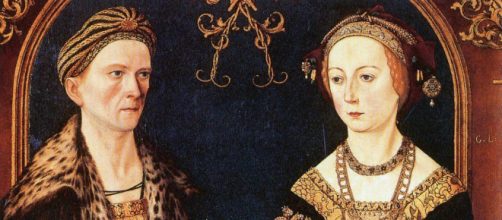The look of brides and grooms in painting is so unremarkable that it’s a wonder the Holburne Museum in Bath, England took it on for a show called “Painted Love: Renaissance Marriage Portraits.”
To talk about this show, it’s handy to have a baseline, a picture of what failed nuptials look like in art. William Hogarth’s “Marriage A-la-Mode” quickly comes to mind.
Turned off
Granted, Hogarth was mocking marriages of convenience, which were popular in 18th century aristocratic circles. What you see is a disinterested groom slumped in a chair several feet away from his equally disinterested bride who plays cards by herself.
Using that image as a baseline, you expect Holbourne Museum’s marriage portraits to show more enthusiasm. But they don’t. Exhibit notes refer to the show as a “lavish” exploration of marriage portraits painted during the Renaissance in Europe. Lavish, yes. Loving, no.
According to the museum, these portraits were used to document marriage. So, maybe it’s not surprising that they look as dry as affidavits.
More than documents, though, the museum says these marriage portraits capture “that key moment in the sitters’ lives, intimate and personal as well as public and formal.”
No. The “public and formal” are plain to see, but “intimate and personal”? Not even a little bit. Consider the 1498 “Marriage Portrait of Jakob Fugger and Sybilla Arzt” by Hans Burgkmair the Elder.
Bored stiff
Not only doesn’t this couple look like newlyweds, but their blank stares also give the impression that they don’t even know each other.
On closer inspection, you can see Jakob clasping his bride’s arm. But you may ask yourself, is he doing that out of affection or simply staking his claim?
Of course, when comparing Jakob’s gesture to the disgruntled groom in Hogarth’s image, Jakob can seem practically feverish for his bride. Then again, maybe it was déclassée to show affection in public.
And as the museum points out, these marriage portraits were about more than coupling. They “also celebrated the union of families, their wealth, power and land, and the forging of political alliance.”
So, maybe the Fuggers don’t look over the moon for each other because wedlock came after years of negotiations.
What you get at this exhibit, then, is the ends of what amounts to simple declarative sentences.
But what accounts for the museum pitching these Renaissance portraits as depictions of “that key moment in the sitters’ lives, intimate and personal.”
And here’s the thing. The impersonal look doesn’t only show up in the Renaissance. A marriage portrait from another era – Thomas Gainsborough’s “Mr. and Mrs. Andrew” – painted more than two centuries after the Fuggers, has the same cold look.
Even though the Andrews are outdoors, they don’t look all that glad about their union any more than the Fuggers. In fact, Mrs. Andrews comes off looking downright cowed as she sits with her hands tightly held in her lap.
One look at her new husband suggests why she looks that way. He stands with a swaggering nonchalantly – one hand in his pocket and one leg crossed over the other – as if to emphasize his detachment.
Wait, there’s more. The cold air of the Andrews’ portrait not only is similar to the mood of the Fuggar portrait, but it also lines up with Hogarth’s mocking “Marriage A-la-Mode.”
All of which can leave you wondering why this museum mounted a show about marriage that appears so unfeeling. Also odd is the inclusion of several portraits of individual young women, presumably brides to be. But without their partners, it’s hard to gauge any sign of love.


